Point Cloud Semantic Segmentation Network Design with Neighborhood Feature Enhancement
Abstract
1. Introduction
- A local feature encoding module PFE is designed to extract geometric features from local regions of the point cloud, including normal vectors and curvature, and then jointly encoded with color and spatial information to obtain richer and more discriminative feature representations.
- An enhanced hierarchical feature extraction module, SAPK, is proposed by integrating the KAN [15] network, using learnable spline functions to better model complex geometries. A residual structure is also adopted to improve feature propagation and reduce gradient vanishing.
- A dual attention mechanism, C-MSCA, is proposed by combining the Multi-Scale Convolutional Attention (MSCA) [16] to dynamically enhance key features and improve perception of local details and global structures.
2. Related Work
2.1. Point-Based Semantic Segmentation
2.2. Feature Extraction
3. Methods
3.1. Overall Framework
3.2. Point Features Encoding
3.3. Improvement of Set Abstraction
3.4. C-MSCA Mechanism
4. Experiments and Discussion
4.1. Dataset
4.2. Evaluation Metrics
4.3. Experiment Settings
4.4. Results and Analysis
4.5. Ablation Study
5. Conclusions
Author Contributions
Funding
Institutional Review Board Statement
Informed Consent Statement
Data Availability Statement
Acknowledgments
Conflicts of Interest
References
- Gong, R.; Sun, R.; Chen, W. Series Active Disturbance Rejection Autopilot Design for Hyper Velocity Projectiles. IEEE Access 2020, 8, 149447–149455. [Google Scholar] [CrossRef]
- Zhou, W.; Berrio, J.S.; Worrall, S.; Nebot, E. Automated Evaluation of Semantic Segmentation Robustness for Autonomous Driving. IEEE Trans. Intell. Transp. Syst. 2019, 21, 1951–1963. [Google Scholar] [CrossRef]
- Yang, B.; Huang, R.; Li, J.; Tian, M.; Dai, W.; Zhong, R. Automated Reconstruction of Building LoDs from Airborne LiDAR Point Clouds Using an Improved Morphological Scale Space. Remote Sens. 2017, 9, 14. [Google Scholar] [CrossRef]
- Chew, A.W.Z.; Ji, A.; Zhang, L. Large-scale 3D point-cloud semantic segmentation of urban and rural scenes using data volume decomposition coupled with pipeline parallelism. Autom. Constr. 2022, 133, 103995–104013. [Google Scholar] [CrossRef]
- Merkle, D.; Reiterer, A. Overview of 3D point cloud annotation and segmentation techniques for smart city applications. In Remote Sensing Technologies and Applications in Urban Environments VII; International Society for Optics and Photonics: Bellingham, WA, USA, 2022; pp. 10–18. [Google Scholar]
- Zhang, J.; Zhao, X.; Chen, Z.; Lu, Z. A review of deep learning-based semantic segmentation for point cloud. IEEE Access 2019, 7, 179118–179133. [Google Scholar] [CrossRef]
- Papon, J.; Abramov, A.; Schoeler, M.; Worgotter, F. Voxel Cloud Connectivity Segmentation—Supervoxels for Point Clouds. In Proceedings of the IEEE Conference on Computer Vision and Pattern Recognition (CVPR), Portland, OR, USA, 25–27 June 2013; pp. 2027–2034. [Google Scholar]
- Ferraz, A.; Bretar, F.; Jacquemoud, S.; Gonçalves, G.; Pereira, L. 3D segmentation of forest structure using a mean-shift based algorithm. In Proceedings of the 2010 IEEE International Conference on Image Processing, Hong Kong, 26–29 September 2010; pp. 1413–1416. [Google Scholar]
- Sampath, A.; Shan, J. Segmentation and Reconstruction of Polyhedral Building Roofs From Aerial Lidar Point Clouds. IEEE Trans. Geosci. Remote Sens. 2010, 48, 1554–1567. [Google Scholar] [CrossRef]
- Biosca, J.M.; Lerma, J.L. Unsupervised robust planar segmentation of terrestrial laser scanner point clouds based on fuzzy clustering methods. ISPRS J. Photogramm. Remote Sens. 2008, 63, 84–98. [Google Scholar] [CrossRef]
- Zhang, X.; Li, G.; Xiong, Y.; He, F. 3D Mesh Segmentation Using Mean-Shifted Curvature. In Proceedings of the 5th International Conference on Geometric Modeling and Processing, Hangzhou, China, 23–25 April 2008; pp. 465–474. [Google Scholar]
- Rabbani, T.; Van Den Heuvel, F.; Vosselmann, G. Segmentation of Point Clouds Using Smoothness Constraint. Int. Arch. Photogramm. Remote Sens. Spat. Inf. Sci. 2006, 36, 248–253. [Google Scholar]
- Christoph Stein, S.; Schoeler, M.; Papon, J.; Worgotter, F. Object Partitioning using Local Convexity. In Proceedings of the IEEE Conference on Computer Vision and Pattern Recognition (CVPR), Columbus, OH, USA, 23–28 June 2014; pp. 304–311. [Google Scholar]
- Krizhevsky, A.; Sutskever, I.; Hinton, G.E. Imagenet classification with deep convolutional neural networks. Adv. Neural Inf. Process. Syst. 2012, 25, 1–9. [Google Scholar] [CrossRef]
- Liu, Z.; Wang, Y.; Vaidya, S.; Ruehle, F.; Halverson, J.; Soljačić, M.; Hou, T.Y.; Tegmark, M. KAN: Kolmogorov-Arnold Networks. arXiv 2024, arXiv:2404.19756. [Google Scholar] [CrossRef] [PubMed]
- Guo, M.H.; Lu, C.Z.; Hou, Q.; Liu, Z.; Cheng, M.M.; Hu, S.M. SegNeXt: Rethinking Convolutional Attention Design for Semantic Segmentation. Adv. Neural Inf. Process. Syst. 2022, 35, 1140–1156. [Google Scholar]
- Qi, C.R.; Su, H.; Mo, K.; Guibas, L.J. PointNet: Deep Learning on Point Sets for 3D Classification and Segmentation. In Proceedings of the IEEE Conference on Computer Vision and Pattern Recognition (CVPR), Honolulu, HI, USA, 21–26 July 2017; pp. 652–660. [Google Scholar]
- Qi, C.R.; Yi, L.; Su, H.; Guibas, L.J. PointNet++: Deep Hierarchical Feature Learning on Point Sets in a Metric Space. Adv. Neural Inf. Process. Syst. 2017, 30, 5105–5114. [Google Scholar]
- Li, Y.; Bu, R.; Sun, M.; Wu, W.; Di, X.; Chen, B. PointCNN: Convolution On X-Transformed Points. Adv. Neural Inf. Process. Syst. 2018, 31, 828–838. [Google Scholar]
- Thomas, H.; Qi, C.R.; Deschaud, J.E.; Marcotegui, B.; Goulette, F.; Guibas, L.J. KPConv: Flexible and Deformable Convolution for Point Clouds. In Proceedings of the IEEE/CVF International Conference on Computer Vision (ICCV), Seoul, Republic of Korea, 27 October–2 November 2019; pp. 6411–6420. [Google Scholar]
- Zhao, H.; Jiang, L.; Fu, C.W.; Jia, J. PointWeb: Enhancing Local Neighborhood Features for Point Cloud Processing. In Proceedings of the IEEE/CVF Conference on Computer Vision and Pattern Recognition (CVPR), Long Beach, CA, USA, 15–20 July 2019; pp. 5565–5573. [Google Scholar]
- Hu, Q.; Yang, B.; Xie, L.; Rosa, S.; Guo, Y.; Wang, Z.; Trigoni, N.; Markham, A. RandLA-Net: Efficient Semantic Segmentation of Large-Scale Point Clouds. In Proceedings of the IEEE/CVF Conference on Computer Vision and Pattern Recognition (CVPR), Seattle, WA, USA, 14–19 June 2020; pp. 11108–11117. [Google Scholar]
- Zhao, H.; Jiang, L.; Jia, J.; Torr, P.H.; Koltun, V. Point Transformer. In Proceedings of the IEEE/CVF International Conference on Computer Vision (ICCV), Virtual, 11–17 October 2021; pp. 16259–16268. [Google Scholar]
- Qian, G.; Li, Y.; Peng, H.; Mai, J.; Hammoud, H.; Elhoseiny, M.; Ghanem, B. PointNeXt: Revisiting PointNet++ with Improved Training and Scaling Strategies. Adv. Neural Inf. Process. Syst. 2022, 35, 23192–23204. [Google Scholar]
- Wu, X.; Jiang, L.; Wang, P.S.; Liu, Z.; Liu, X.; Qiao, Y.; Ouyang, W.; He, T.; Zhao, H. Point Transformer V3: Simpler Faster Stronger. In Proceedings of the IEEE/CVF Conference on Computer Vision and Pattern Recognition (CVPR), Seattle, WA, USA, 17–18 June 2024; pp. 4840–4851. [Google Scholar]
- Guo, M.H.; Cai, J.X.; Liu, Z.N.; Mu, T.J.; Martin, R.R.; Hu, S.M. Pct: Point cloud transformer. Comput. Vis. Media 2021, 7, 187–199. [Google Scholar] [CrossRef]
- Liu, Y.; Fan, B.; Meng, G.; Lu, J.; Xiang, S.; Pan, C. Densepoint: Learning densely contextual representation for efficient point cloud processing. In Proceedings of the IEEE/CVF International Conference on Computer Vision, Seoul, Republic of Korea, 27 October–2 November 2019; pp. 5239–5248. [Google Scholar]
- Xu, M.; Ding, R.; Zhao, H.; Qi, X. Paconv: Position adaptive convolution with dynamic kernel assembling on point clouds. In Proceedings of the IEEE/CVF Conference on Computer Vision and Pattern Recognition, Virtual, 19–25 June 2021; pp. 3173–3182. [Google Scholar]
- Zhang, C.; Wan, H.; Shen, X.; Wu, Z. PVT: Point-voxel transformer for point cloud learning. Int. J. Intell. Syst. 2022, 37, 11985–12008. [Google Scholar] [CrossRef]
- Yu, X.; Tang, L.; Rao, Y.; Huang, T.; Zhou, J.; Lu, J. Point-bert: Pre-training 3D point cloud transformers with masked point modeling. In Proceedings of the IEEE/CVF Conference on Computer Vision and Pattern Recognition, New Orleans, LA, USA, 18–24 June 2022; pp. 19313–19322. [Google Scholar]
- Armeni, I.; Sener, O.; Zamir, A.R.; Jiang, H.; Brilakis, I.; Fischer, M.; Savarese, S. 3D Semantic Parsing of Large-Scale Indoor Spaces. In Proceedings of the IEEE Conference on Computer Vision and Pattern Recognition (CVPR), Las Vegas, NV, USA, 27–30 June 2016; pp. 1534–1543. [Google Scholar]
- Yan, X.; Zheng, C.; Li, Z.; Wang, S.; Cui, S. PointASNL: Robust Point Clouds Processing Using Nonlocal Neural Networks With Adaptive Sampling. In Proceedings of the IEEE/CVF Conference on Computer Vision and Pattern Recognition (CVPR), Seattle, WA, USA, 14–19 June 2020; pp. 5589–5598. [Google Scholar]
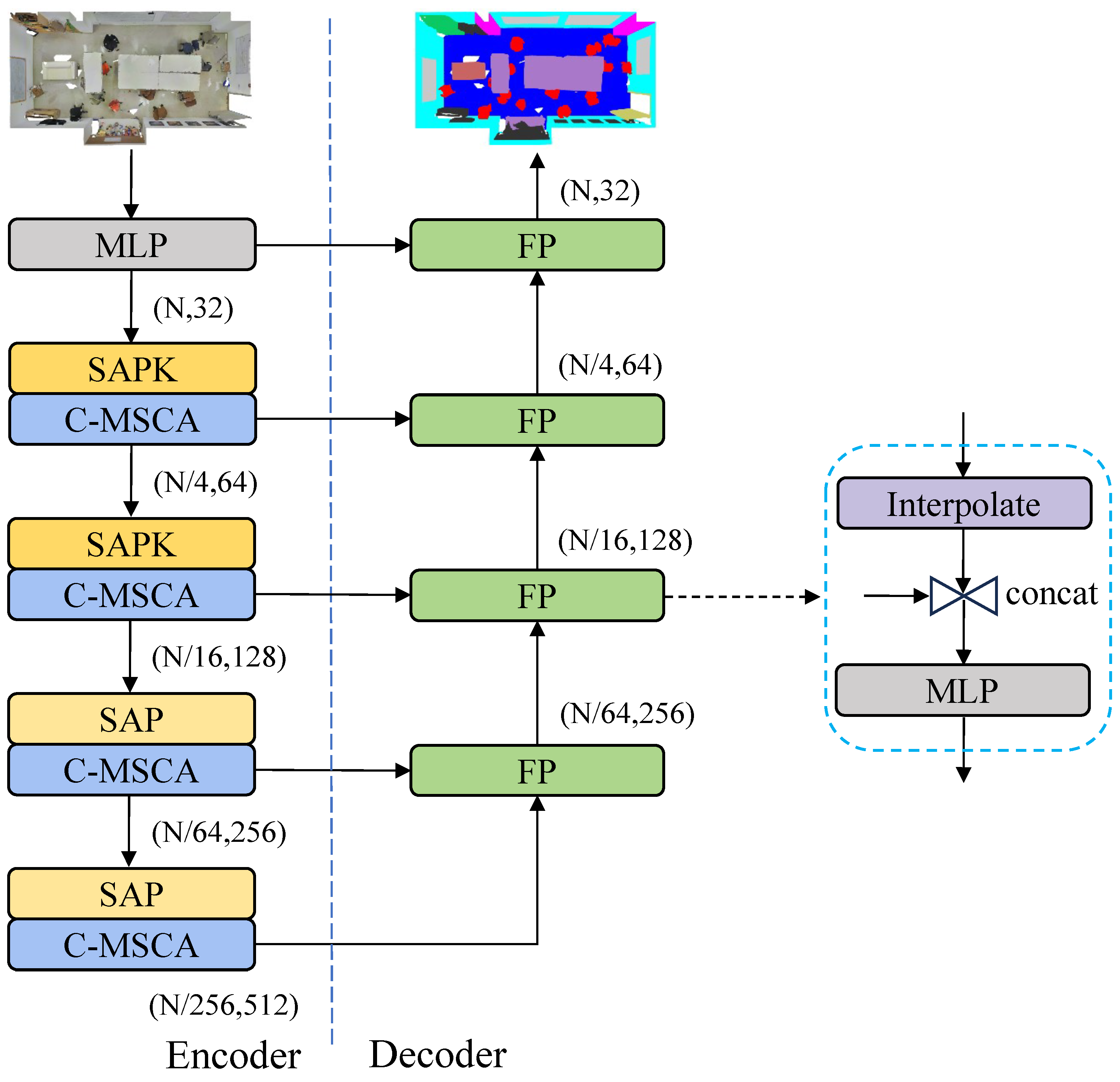
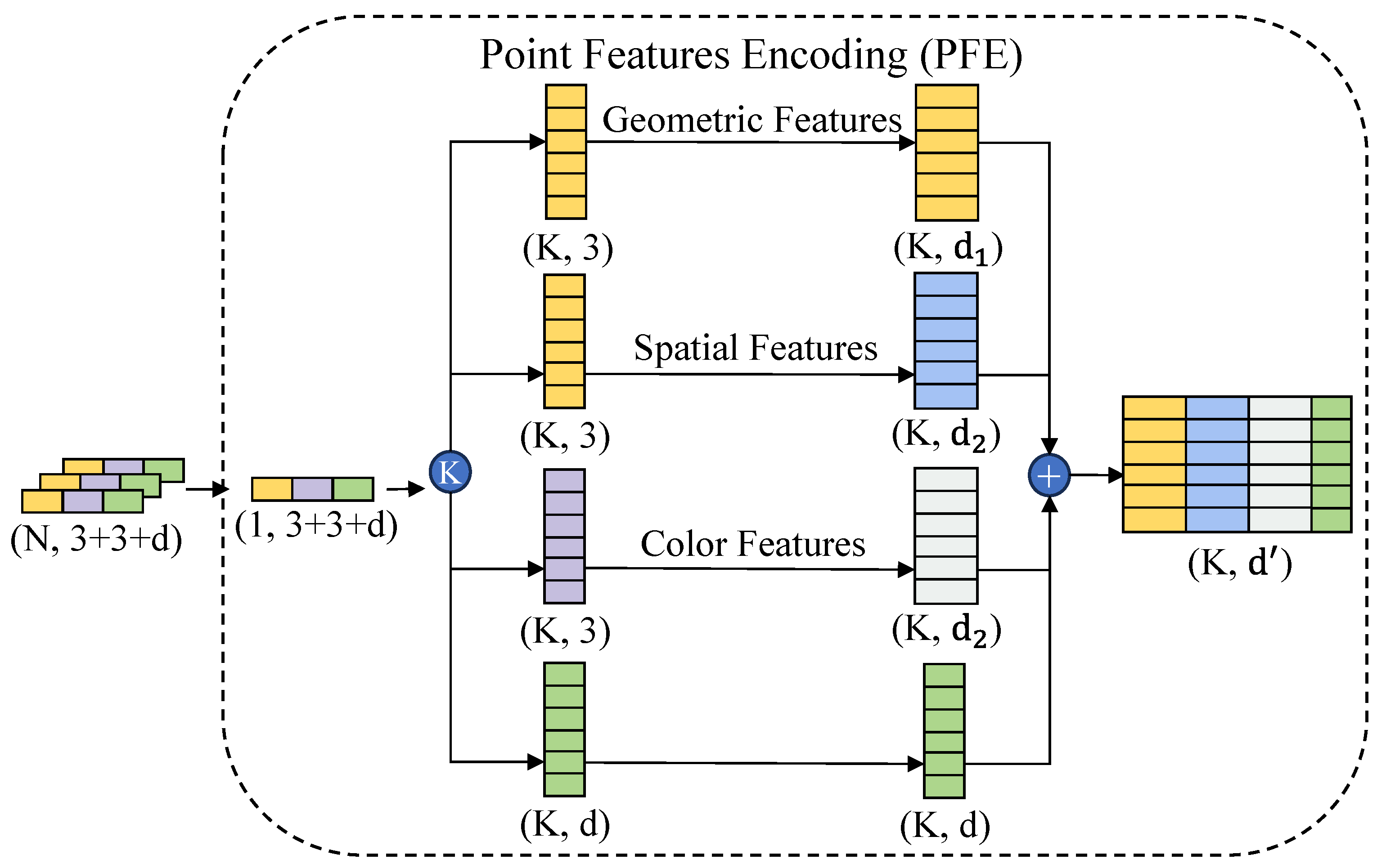
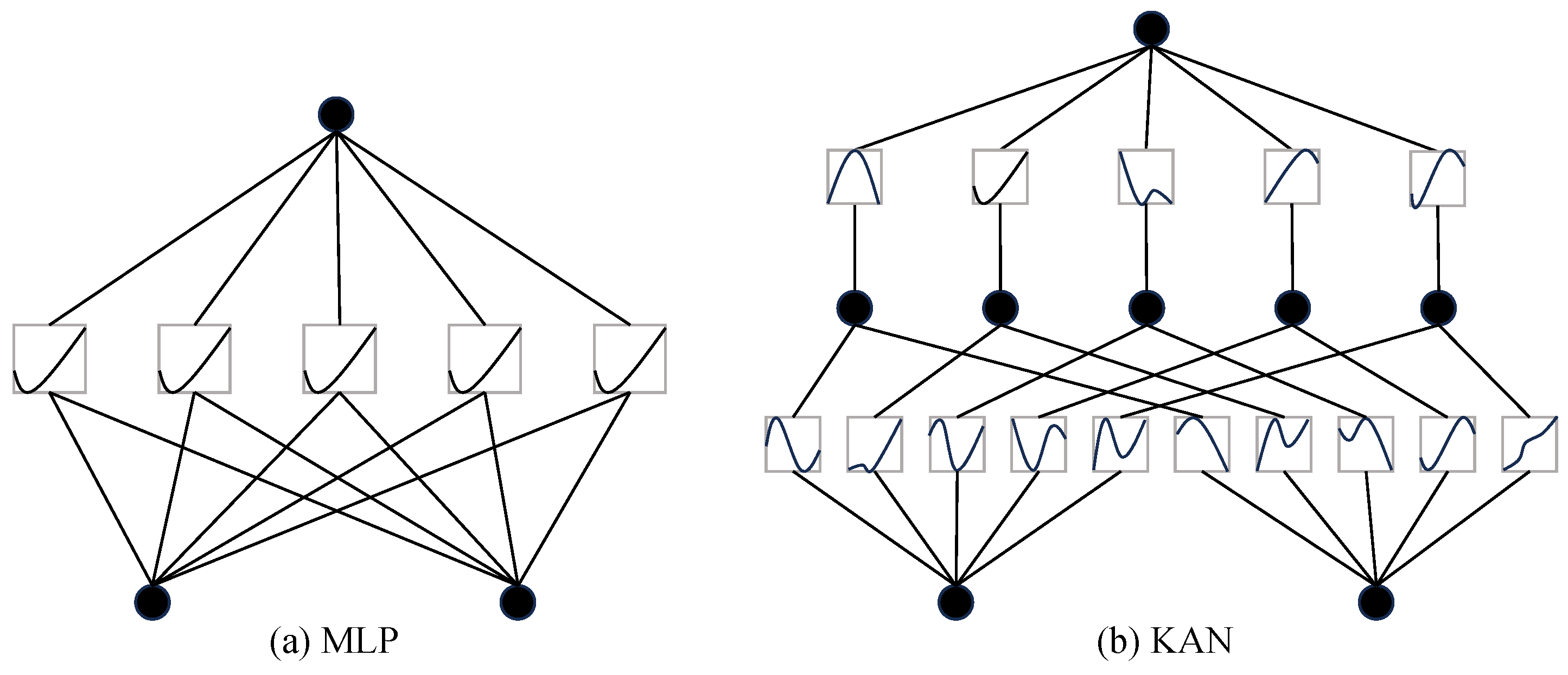
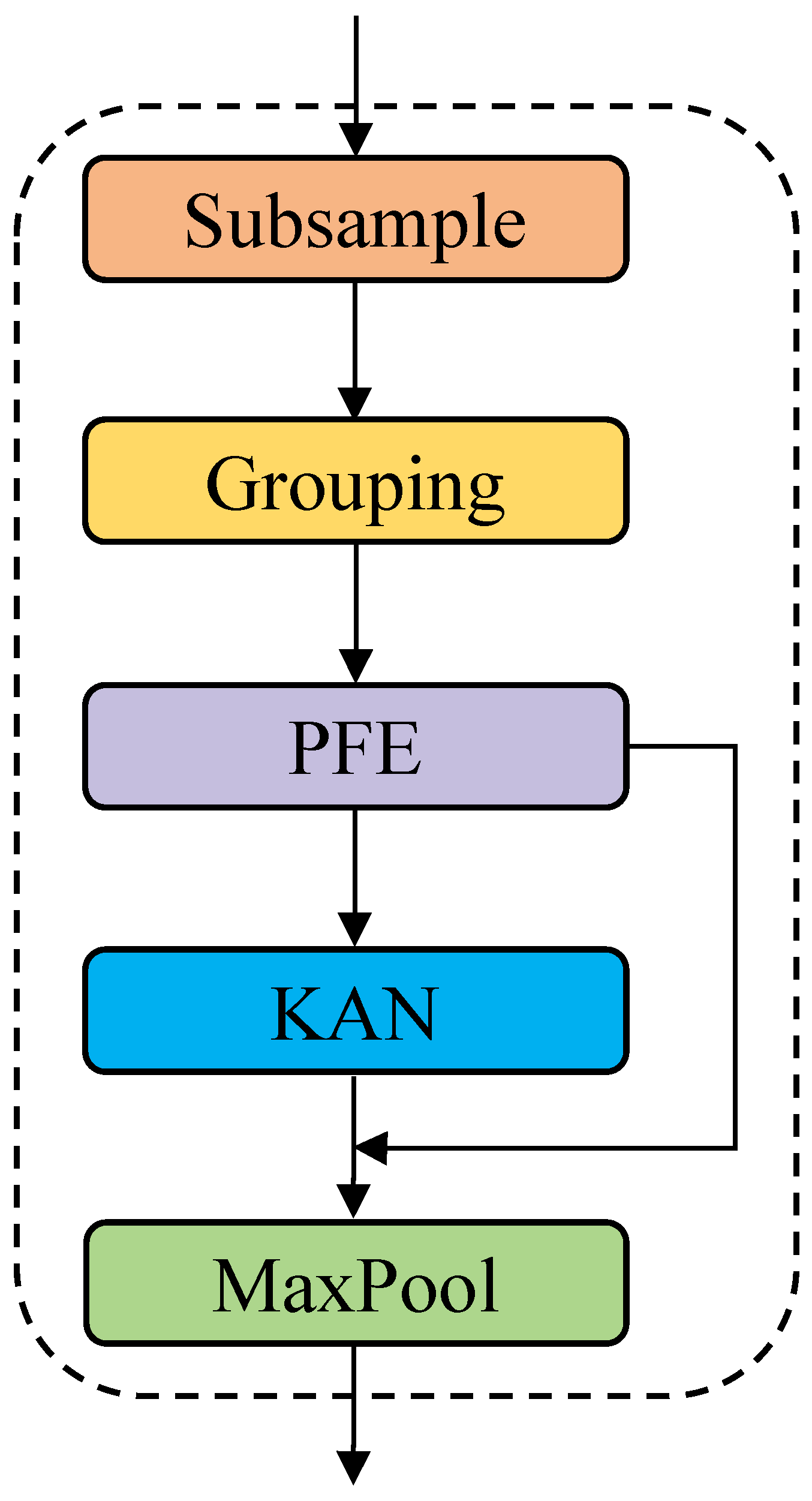

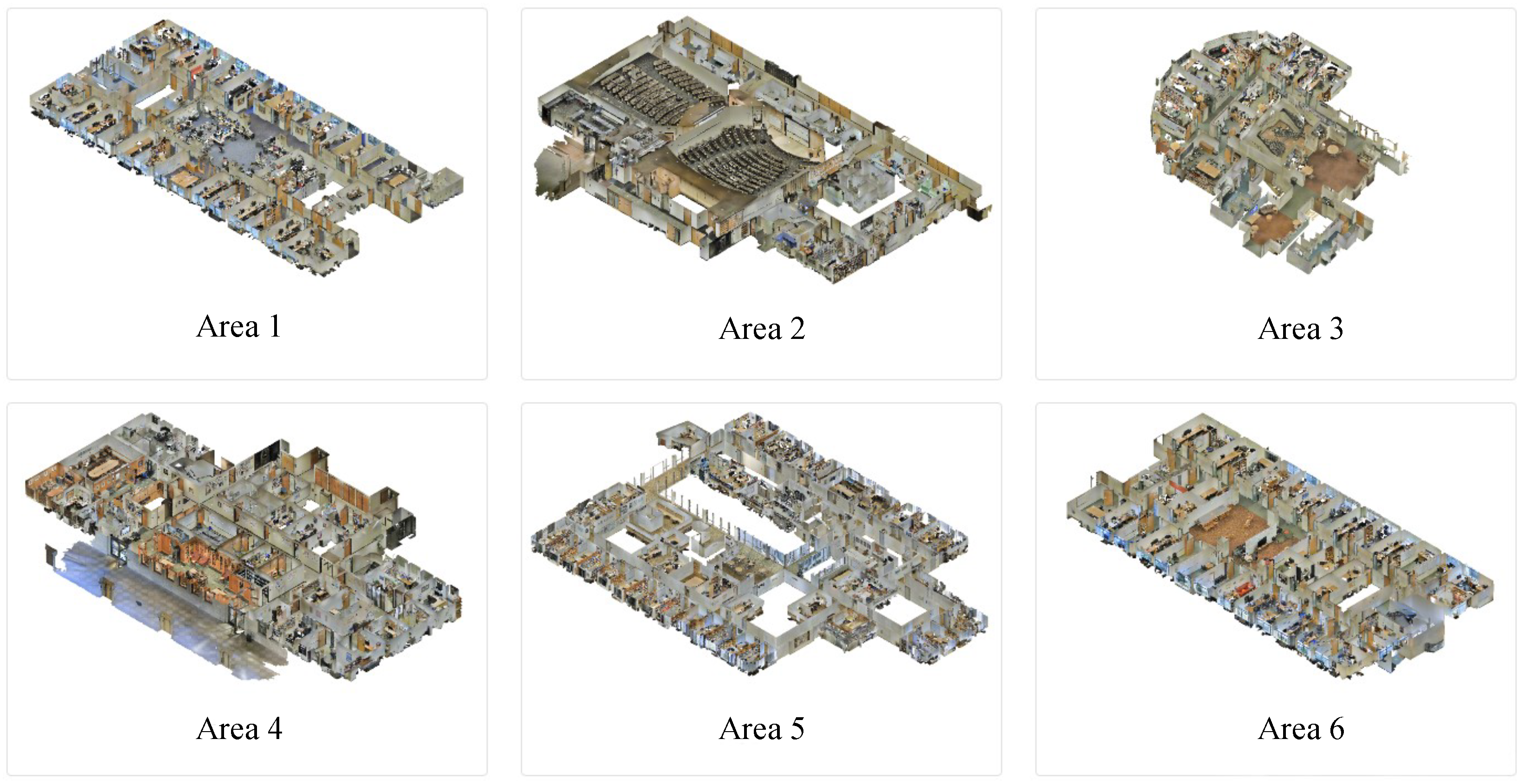
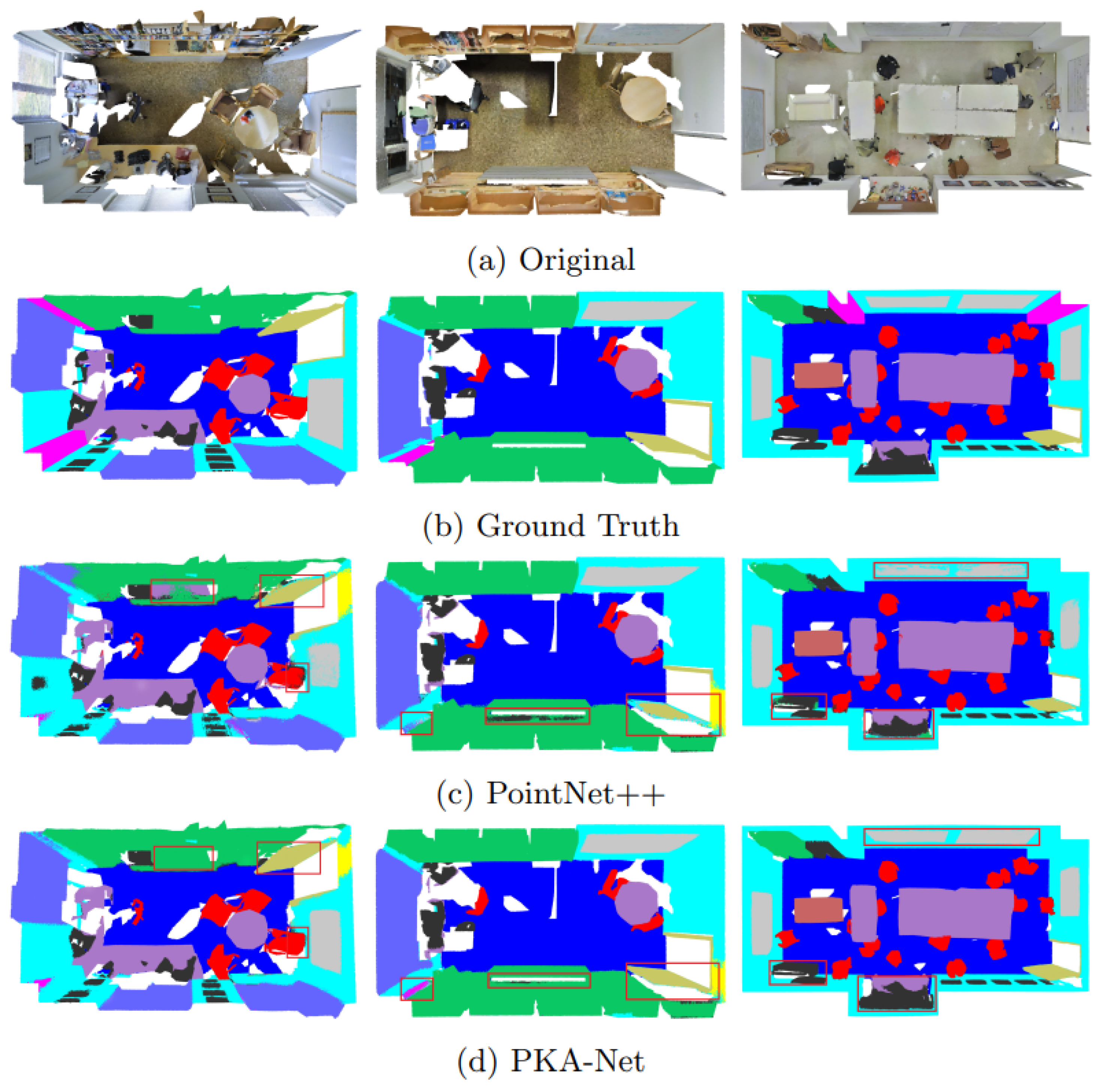
| Configuration | Value |
|---|---|
| Operation System | Ubuntu-20.04 |
| CPU | Intel(R) Xeon(R) CPU E5-2696 |
| GPU | NVIDIA GeForce RTX 3090 |
| Framework | Pytorch 2.3.1 |
| CUDA | 12.2 |
| Methods | OA (%) | mAcc (%) | mIoU (%) |
|---|---|---|---|
| PointNet | - | 49.0 | 41.1 |
| PointCNN | 85.9 | 63.9 | 57.3 |
| PointWeb | 87.0 | 66.6 | 60.3 |
| RandLA-Net | 87.6 | 70.6 | 62.7 |
| Patchformer | 89.4 | - | 67.2 |
| PointNeXt-B | 89.4 | - | 67.3 |
| PointNet++ | 87.7 | 70.9 | 63.6 |
| PKA-Net | 89.8 | 73.8 | 67.6 |
| Categories | PointNet | PointCNN | PointWeb | RandLA-Net | PointNeXt-B | PointNet++ | PKA-Net |
|---|---|---|---|---|---|---|---|
| Ceiling | 88.8 | 92.3 | 92.0 | 92.6 | 92.8 | 91.3 | 92.4 |
| Floor | 97.3 | 98.2 | 98.5 | 97.9 | 97.3 | 97.0 | 98.0 |
| Wall | 69.8 | 79.4 | 79.4 | 81.2 | 82.3 | 80.9 | 82.6 |
| Beam | 0.1 | 0.0 | 0.0 | 0.0 | 0.0 | 0.0 | 0.0 |
| Column | 3.9 | 17.6 | 21.1 | 21.8 | 23.9 | 19.9 | 24.3 |
| Window | 46.3 | 22.8 | 59.7 | 60.9 | 58.1 | 54.7 | 61.0 |
| Door | 10.8 | 62.1 | 34.8 | 43.4 | 69.2 | 58.8 | 64.1 |
| Table | 59.0 | 74.4 | 76.3 | 77.6 | 91.1 | 79.4 | 89.1 |
| Chair | 52.6 | 80.6 | 88.3 | 86.8 | 82.1 | 86.9 | 88.3 |
| Sofa | 5.9 | 31.7 | 46.9 | 64.6 | 76.2 | 70.1 | 76.8 |
| Bookshelf | 40.3 | 66.7 | 69.3 | 70.0 | 75.4 | 71.7 | 73.5 |
| Board | 26.4 | 62.1 | 64.9 | 66.0 | 66.8 | 65.1 | 69.1 |
| Clutter | 33.2 | 56.7 | 52.5 | 52.2 | 59.1 | 51.4 | 59.3 |
| Methods | mIoU (%) |
|---|---|
| PointNet++ | 55.7 |
| PointCNN | 49.8 |
| PointASNL | 66.6 |
| RandLA-Net | 64.5 |
| KPConv | 68.4 |
| PKA-Net | 69.0 |
| Categories | PointNet++ | PointCNN | PointASNL | KPConv | PKA-Net |
|---|---|---|---|---|---|
| wall | 75.6 | 75.1 | 80.6 | 81.9 | 82.5 |
| floor | 94.6 | 94.1 | 95.1 | 93.5 | 95.0 |
| bed | 66.1 | 64.4 | 78.1 | 75.8 | 79.1 |
| chair | 74.4 | 71.1 | 83.0 | 81.4 | 84.5 |
| sofa | 64.3 | 52.9 | 75.1 | 78.5 | 79.1 |
| table | 49.7 | 50.9 | 55.3 | 61.4 | 60.3 |
| door | 37.5 | 35.2 | 53.7 | 59.4 | 58.7 |
| desk | 45.1 | 43.6 | 47.4 | 60.5 | 57.4 |
| sink | 55.3 | 49.3 | 67.5 | 69.0 | 70.5 |
| toilet | 82.4 | 81.3 | 81.6 | 88.2 | 88.4 |
| cabinet | 49.1 | 42.0 | 65.5 | 64.7 | 65.3 |
| picture | 20.5 | 15.5 | 27.9 | 18.1 | 25.5 |
| counter | 39.2 | 22.9 | 47.1 | 47.3 | 48.0 |
| curtain | 53.9 | 41.4 | 76.9 | 77.2 | 74.7 |
| window | 51.5 | 50.4 | 70.3 | 63.2 | 71.3 |
| bathtub | 73.5 | 55.9 | 70.3 | 84.7 | 78.2 |
| bookshelf | 68.6 | 56.0 | 75.1 | 78.4 | 77.1 |
| refrigerator | 40.3 | 23.8 | 63.5 | 58.7 | 60.5 |
| shower curtain | 35.6 | 38.7 | 69.8 | 80.5 | 74.8 |
| other furniture | 37.6 | 32.4 | 47.5 | 45.0 | 48.7 |
| Model | PFE | SAPK | C-MSCA | OA (%) | mAcc (%) | mIoU (%) |
|---|---|---|---|---|---|---|
| Baseline | 87.7 | 70.9 | 63.6 | |||
| Model1 | ✓ | 88.8 | 72.5 | 65.7 | ||
| Model2 | ✓ | 89.0 | 73.0 | 66.1 | ||
| Model3 | ✓ | 88.5 | 72.1 | 64.7 | ||
| Model4 | ✓ | ✓ | 89.1 | 72.9 | 66.2 | |
| PKA-Net (Ours) | ✓ | ✓ | 89.8 | 73.8 | 67.6 |
Disclaimer/Publisher’s Note: The statements, opinions and data contained in all publications are solely those of the individual author(s) and contributor(s) and not of MDPI and/or the editor(s). MDPI and/or the editor(s) disclaim responsibility for any injury to people or property resulting from any ideas, methods, instructions or products referred to in the content. |
© 2025 by the authors. Licensee MDPI, Basel, Switzerland. This article is an open access article distributed under the terms and conditions of the Creative Commons Attribution (CC BY) license (https://creativecommons.org/licenses/by/4.0/).
Share and Cite
He, S.; Li, X. Point Cloud Semantic Segmentation Network Design with Neighborhood Feature Enhancement. Appl. Sci. 2025, 15, 11700. https://doi.org/10.3390/app152111700
He S, Li X. Point Cloud Semantic Segmentation Network Design with Neighborhood Feature Enhancement. Applied Sciences. 2025; 15(21):11700. https://doi.org/10.3390/app152111700
Chicago/Turabian StyleHe, Shi, and Xiang Li. 2025. "Point Cloud Semantic Segmentation Network Design with Neighborhood Feature Enhancement" Applied Sciences 15, no. 21: 11700. https://doi.org/10.3390/app152111700
APA StyleHe, S., & Li, X. (2025). Point Cloud Semantic Segmentation Network Design with Neighborhood Feature Enhancement. Applied Sciences, 15(21), 11700. https://doi.org/10.3390/app152111700






